With the popularization of heart rate monitors, more and more athletes are paying attention to this physiological measurement. But what about maximum heart rate? What’s the best way to calculate (or measure) your maxHR? And is it possible to increase your maximum heart rate with training? The answer to this last question will undoubtedly surprise you.
In this article, I’m going to review what we know about maximal exercise heart rate. I’ll also share with you some of the data I’ve collected over the last few years during my physiological assessments. By reading this article, you’ll understand everything you need to know about maximum heart rate and its usefulness for training.
Let’s start with the basics.
Why does Heart Rate increase during Effort?
The heart is a muscle which (among other things) helps circulate the blood around our body. Blood loaded with CO2 (carbon dioxide) returns to the heart via the veins. It is then charged with oxygen (and relieved of its CO2) in the pulmonary capillaries. The oxygenated blood is finally propelled to the muscles and organs by the left ventricle.
During physical effort, muscles consume more oxygen. The body increases heart rate to meet this increasing demand for O2. The increase in heart rate during exercise is due most notably to stimulation of the sympathetic branch of the autonomic nervous system.

Maximum heart rate is measured in beats per minute (abbreviated “bpm”).
Influences on Increased Heart Rate
Several internal and external factors have a direct influence on heart rate during exercise.
If you train in a hot environment, your heart rate will be higher than usual. Your body uses blood to transport oxygen as well as to dissipate internal heat. In high temperatures, your body redirects some of the blood to the skin to lower your internal temperature.
Altitude is another external factor influencing your heart rate, both at rest and during physical activies. When you’re at altitude, the oxygen available in the air is much lower than at sea level. As a result, your body increases its heart rate to supply muscles and organs with the necessary oxygen.
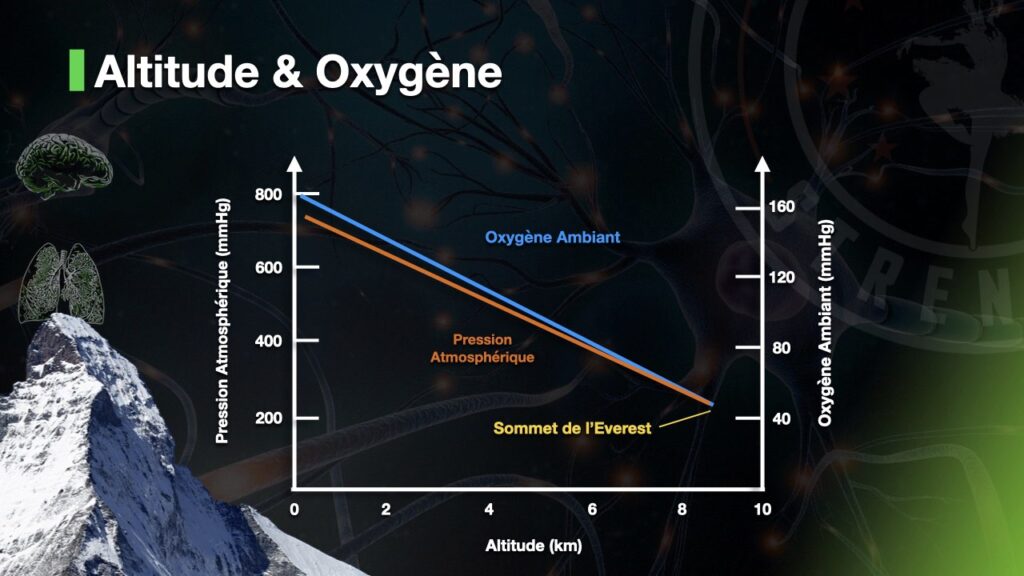
If you’re ill, it’s common to measure higher-than-normal heart rates. In this case, inflammation and elevated body temperature seem to be the cause of a high HR.
You now understand the different mechanisms that increase heart rate. Now let’s see if there’s a direct link between maximum heart rate and sports performance.
Max Heart Rate & Sports Performance
Contrary to popular belief, a high maximum heart rate is not associated with better sporting performance. In fact, the opposite seems to be true.
In a 2000 study, Zavorsky explains that as physical fitness (VO2max) increases, HRmax seems to decrease. By as much as 7%. This can be explained by the fact that endurance training increases blood plasma volume. The more blood there is in the body, the more the heart fills up before each beat (called “ventricular preload”), and the more blood it can eject with each beat. If the heart ejects more blood with each beat, it will beat slower (for a given total volume).
Cardiac output equation Q = HR x SV
Q = Cardiac Output || HR = Heart Rate || SV = Stroke Volume
In a recent study comparing cycling and running data, Kasiak et al. observed that sedentary subjects express a lower maximum heart rate on average than trained subjects.
Different Max HR Between Men & Women
In a study conducted in 2014 with over 37,000 subjects, researchers showed that men had a higher Max HR than women (3 beats difference on average).
I was also able to observe this slight difference in the physiological testing results. Note that the demographic illustrated in my data is essentially CrossFitⓇ competitors evaluated on a BikeErg using Protocol 41.
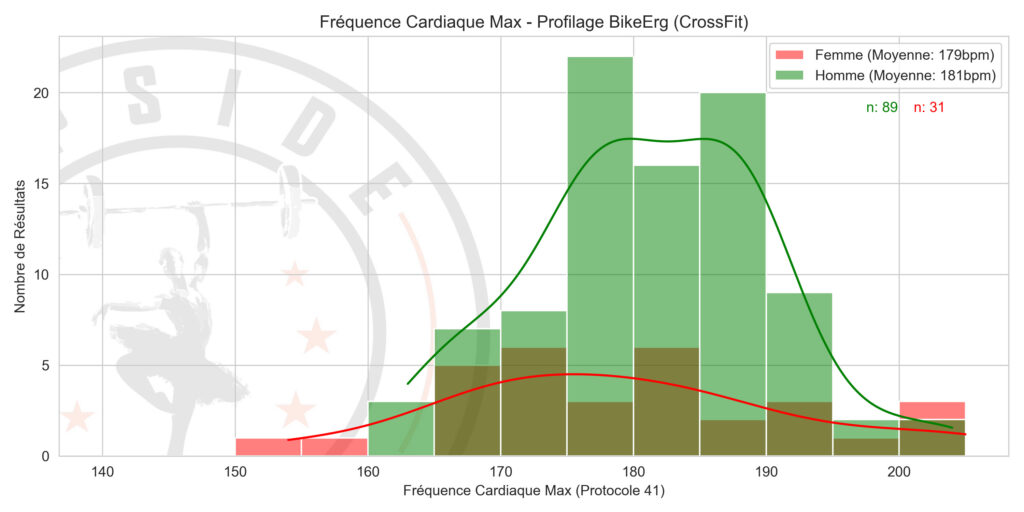
Maximum Heart Rate as a Function of Age
Maximum heart rate tends to fall linearly with age. That said, there is a wide variation in Maximum Heart Rate from one person to another. It seems that women’s Max Heart Rate declines more slowly than men’s over the years.
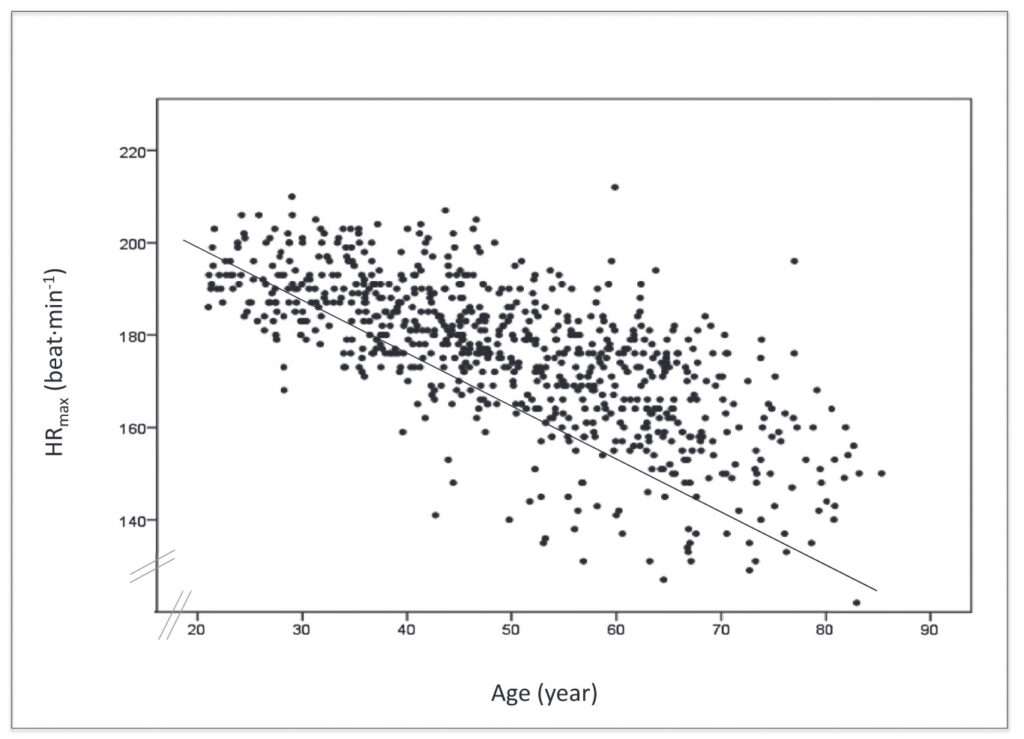
Before we look at the different ways of measuring maximum heart rate during exercise, let’s see what calculations are used to determine a theoretical max heart rate.
How to Calculate your Maximum Heart Rate?
Calculations to determine maximum (estimated) heart rate have an undeniable advantage: they provide a reference value for individuals who are not capable of maximum effort.
The best-known formula for estimating an individual’s MaxHR is as follows:
220 – age
From my digging into the scientific literature, it would appear that this equation has no definite source. Potentially, it comes from a 1971 study, but this link remains uncertain.
While this equation seems to correspond well to the average of measured HRmax values, it has a considerable margin of error (plus or minus 15 beats). If we refer to the graph above, we can see that a large number of points deviate considerably from the average (black line).
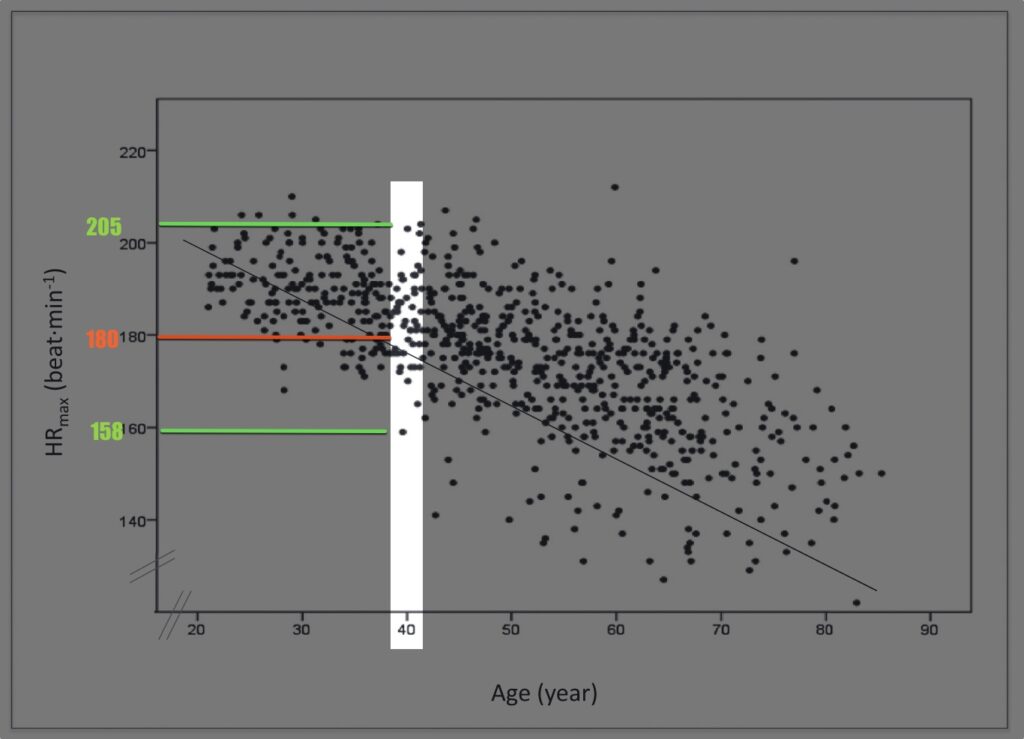
To take a concrete example, the theoretical maximum heart rate for a 40-year-old is 180bpm (220 – 40 = 180). However, measured values range from 158 to 205 beats per minute. This margin of error is far too large for practical use.
Are there better formulas for calculating Maximum heart rate more accurately?
There are dozens of alternative formulas for calculating an individual’s maximum heart rate. I could detail them here, but I think it’s wiser to go straight to the conclusion of Robergs et al in their 2002 review:
“Currently, there is no acceptable method to estimate HRmax.”
We’ll come back later to the benefits (or really??) of estimating max heart rate in order to define heart rate training zones.
But first, let’s take a look at which field tests can directly measure the highest possible heart rate.
Protocols for Measuring Maximum Heart Rate
There is currently no specific protocol for measuring maximal heart rate during exercise.
When you want to measure your maximum heart rate, you should meet at least two conditions:
- Be in a state of fitness/health that enables us to produce a maximum effort
- Choose a test that is long enough and/or intense enough to elicit a max HR.
As long as you’re in good health, you can use a multitude of tests to measure your maximum heart rate. For example, you can use a MAS Test, a Cooper or 1/2 Cooper running test, or a FTP (20-minute) cycling test.
For my part, I use Protocol 41 to measure lactate thresholds, heart rate, oxygen consumption (VO2) and muscle oximetry. With this protocol, I can measure the average heart rate at each level as well as the maximum heart rate on the last stage completed.
It’s interesting to note that for the same individual, different modalities will elicit different max heart rate measurements. Let’s take a look at this in the next part of the article.
Max Heart Rate by Sport
There are several reasons why heart rate differs according to sporting activity.
First and foremost, the body’s position in space plays an important role. Take running and swimming, for example. When running, the body is vertical, whereas when swimming, the body is completely horizontal. You can do the test yourself: lie down on your bed and measure your heart rate for 60 seconds. Then stand up and measure your heart rate standing up. See the difference?
Secondly, the muscle mass involved in each activity is different. The more muscle mass is recruited, the higher the heart rate will have to be to supply these tissues with oxygen.

Finally, you need to take into account the type of muscular contraction involved in each physical activity. In running, each stride produces an impact that must be absorbed. Muscle contractions therefore have a significant eccentric component. Cycling, on the other hand, has no eccentric phase, and the absence of impact considerably changes muscular and therefore cardiac demands.
In general, it can be assumed that an individual will reach his or her highest maximum heart rate when running. The maximum heart rate for cycling will be slightly lower, and the maximum heart rate for swimming will be even lower than for cycling.
There are exceptions, however. In the case of a top-level cyclist, it’s highly likely that their HR max on the bike will be higher than their peak rate on the run. The person’s training status in a given modality should therefore also be taken into account.
Let’s take a look at how maximum heart rate can be used for zones.
Maximum Heart Rate to Determine Training Zones
Max heart rate is mainly used to determine cardiac training zones. These zones enable us to individualize our training and target intensities that are in line with our goals.
But there’s a big problem with this approach.
Most people determine their training zones according to fixed percentages of their HRmax (calculated or measured). And just as there’s a significant margin of error in calculating HRmax, the same applies to HRmax percentages at different zones.
The graph below illustrates the distribution of threshold 1 as a percentage of (measured) HRmax. Threshold 1 marks the transition between Zone 2 and Zone 3. We can see that the average falls just short of 70% of max heart rate, which is commonly used for zone calculations. But we can also see that there is a wide variation above and below 70%.
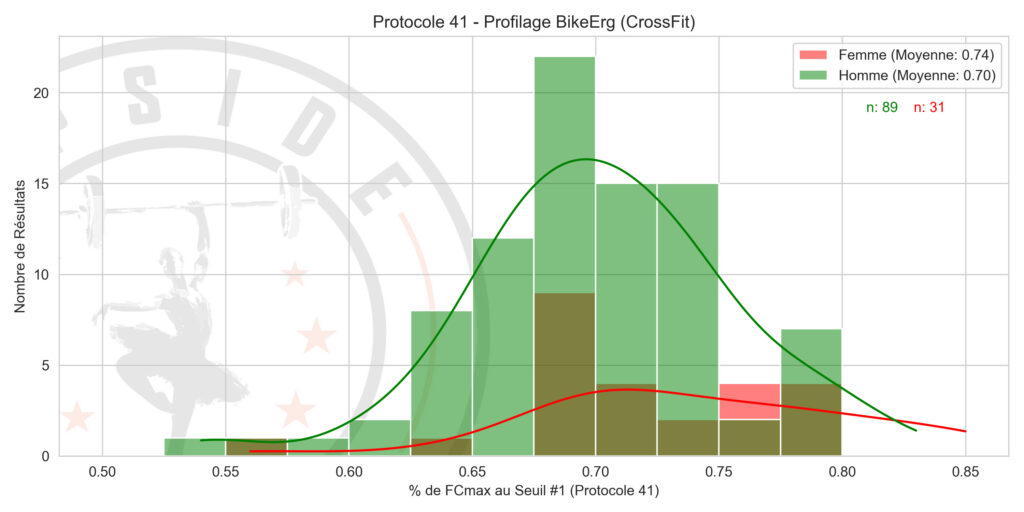
An Alternative to Max Heart Rate Percentages
In the absence of physiological data enabling us to rigorously determine the two thresholds, I recommend using the Rating of Perceived Exertion (RPE) to estimate the zones. This approach requires good self-awareness and is unfortunately not taught widely enough.
It’s an important quality that will bring you enormous benefits in your sporting activities. In a world dominated by data and gadgets, knowing how to quantify and manage your own effort is almost like a superpower!
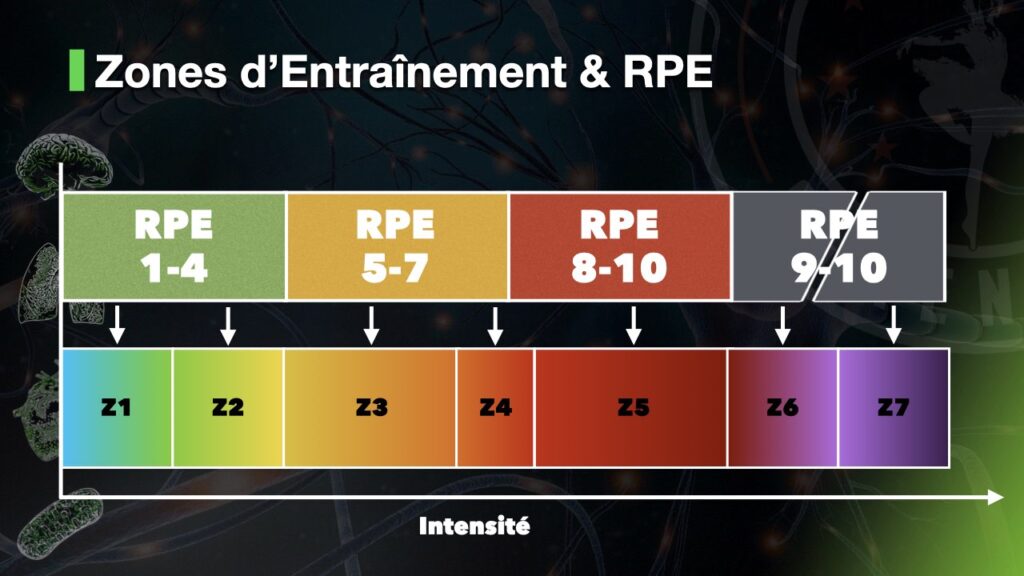
Before ending this article, I’d like to talk about a phenomenon I’ve observed on several occasions. I’m talking about the increase in MaxHR with training…
Is it Possible to Increase your Maximum Heart Rate?
Theoretically, HRmax is not a value that can be directly influenced. But in my various evaluations, I’ve come across a number of cases where the peak heart rate did indeed increase following targeted training.
So what’s that about?
These changes were seen in subjects who had followed my Bike ENDURE training program between their two assessments. First, I’ll show you the data I collected. Then I’ll share with you my hypothesis concerning the increase in their HRmax.
All these tests were carried out on a BikeErg using Protocol 41.
Mattéo: Lactate Curve & Maximum HR
This first subject completed two identical assessments 5 months apart. In the meantime, he followed my Bike ENDURE program for 10 weeks. We can see that on the second evaluation, he completed 2 more stages than on the initial test. There’s also a clear change in his lactate curve. His heart rate climbed to 203bpm, compared with 194bpm on the initial test.
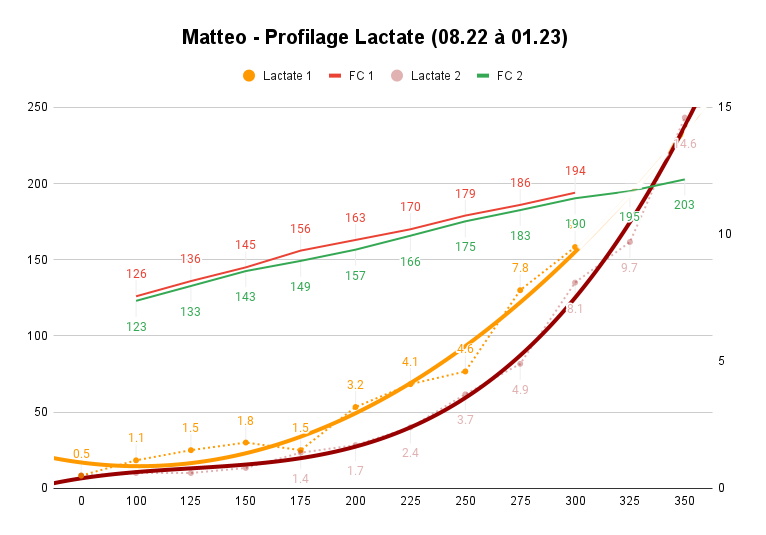
Thomas: Maximal and submaximal heart rate
For this subject, the difference in HRmax is less obvious. There is, however, a slight increase in maximum frequency, from 167 to 169bpm. The biggest change was in the submaximal HR at each stage. He had also followed the Bike ENDURE program.
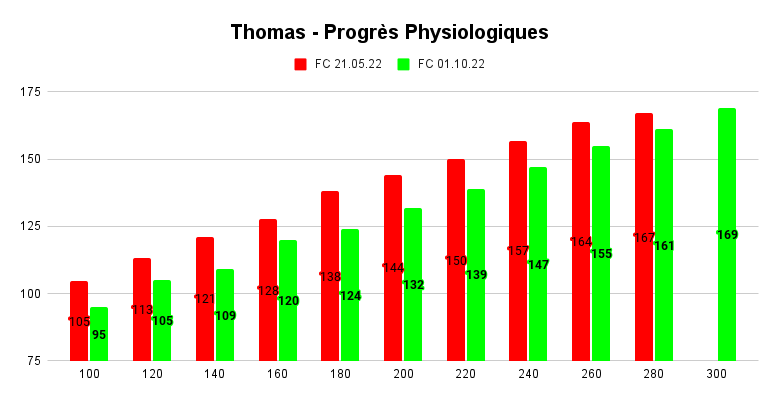
Andreas: Maximum and Sub-Maximum HR
This third subject expresses a maximum heart rate 11 beats higher during the second evaluation (177bpm vs. 166bpm). A considerable change!
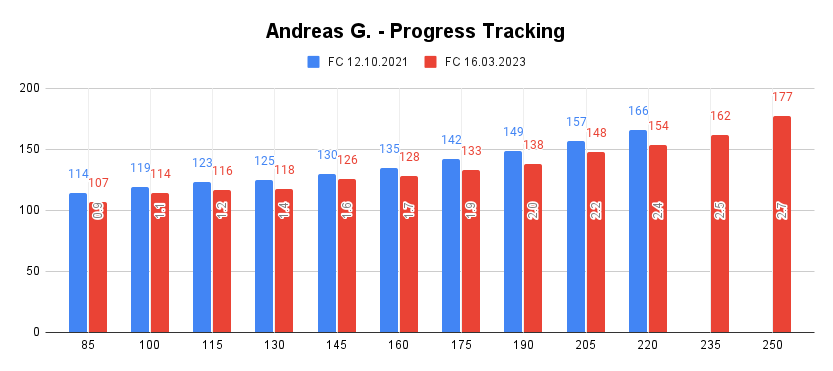
Alex: Lactate curve & FC Max
This last subject completed two identical assessments 12 months apart. During this time, he alternated between my Bike ENDURE and Bike POWER programs to develop all his endurance qualities for CrossFitⓇ. You can see the full details of his workouts here. Once again, we see a significant difference in maximum heart rate (188bpm vs. 171 in the first test). We can also see a nice evolution in his lactate curve and performance. He completes 3 more stages in the second test than he did in the first.
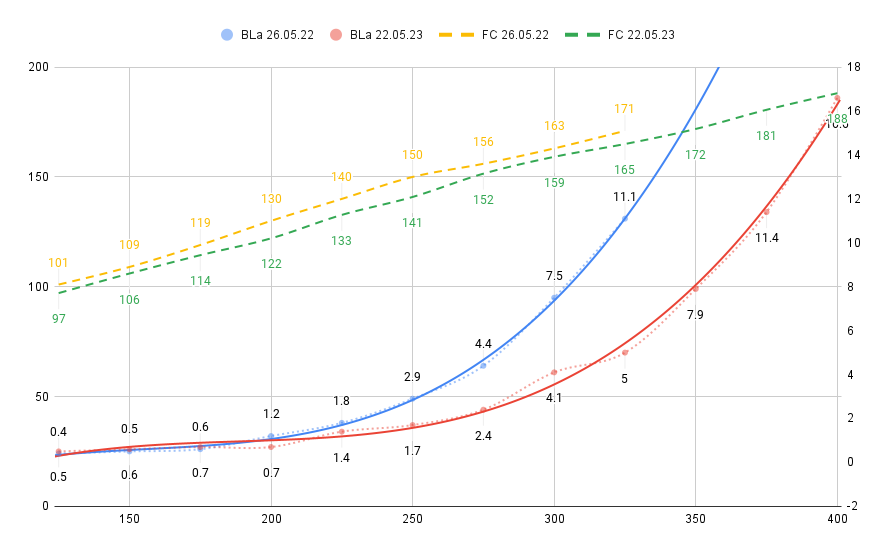
So why is Max Heart Rate increasing?
The Bike ENDURE program develops important endurance qualities such as mitochondrial density and the ability to recycle lactate. My best explanation for the increase in HRmax is as follows:
These subjects were all, in one way or another, limited by their muscular system, or their metabolism. What I mean is that they didn’t seem to be limited by their respiratory or cardiovascular systems. Upon initial assessment, the HRmax they expressed was nothing more than the HRmax their legs would allow them to achieve. Following a training program that developed their “muscular resistance” and their “metabolism”, they were able to go further in the test and in their effort and thus express a higher maximum heart rate.
Takeaways:
- Calculations to estimate maximum heart rate are imprecise at best.
- Zones based on % of maxHR are often wrong (unless you’re lucky!).
- The maximum heart rate for the same person may vary according to training modality and level.
In conclusion, I don’t think you can base training or training parameters (zones) on HRmax, whether measured or estimated. At best, this value can be used as a point of comparison over time to quantify your state of fitness on a structured test such as Protocol 41.
If you enjoyes this article, please share it with someone around you who can benefit from it!
If you too want to develop your endurance and recovery capacity, join over 200 participants in the Bike ENDURE program by clicking here.
References:
Evidence and Possible Mechanisms of Altered Maximum Heart Rate With Endurance Training and Tapering (Zavorsky et al, 2000)
Maximal heart rate declines linearly with age independent of cardiorespiratory fitness levels (Ozemek et al, 2014)
Reference Values for Cardiorespiratory Response and Fitness on the Treadmill in a 20- to 85-Year-Old Population (Edvardsen et al, 2013)
Relationship between exercise heart rate and age in men vs women (Sydo et al, 2014)
The surprising history of the “HRmax=220-age” equation (Robergs et al, 2002)
Validity of the Maximal Heart Rate Prediction Models among Runners and Cyclists (Kasias et al, 2023)
Maximum Heart Rate: Frequently Asked Questions
There’s no maximal heart rate you can’t exceed. The important thing is to train at intensities that are in line with your goals and current capacities.
Maximum heart rate varies greatly from person to person, depending on age, sex, training modality and training level. The FCmax range is between 140 and 220.
Max heart rate is not really a physiological limit. As we saw in the article, it is possible to increase your heart rate with the right training.
The heart rate you need to maintain during exercise will depend mainly on your level of training and the objective of the session. As there’s a wide variation in heart rate between individuals, there’s no ideal rhythm for everyone.
A fit heart is generally characterized by low resting heart rates (sub 50bpm) and stable values at high levels of intensity.
Heart rate decreases progressively with age. The 220 – age calculation is commonly used, even if the margin of error is enormous (+ or – 15 beats).
There is no ideal % MHR for weight loss. The best approach combines (mild) caloric restriction with a structured training program that will be maintained over time.
A heart rate that rises rapidly on exertion is generally a sign of a lack of fitness. Choose low-intensity training (Zone 2 type) to build up quality volume and improve your heart rate during exercise.
There’s no such thing as a perfect heart rate. The important thing is to train at intensities that are in line with your goals and current abilities.
Heart rate over 10km can vary greatly from one person to another. There is no perfect heart rate for a 10km run.
Absolutely! A well-structured training program can not only lower your resting heart rate, but also your heart rate at different levels of effort.
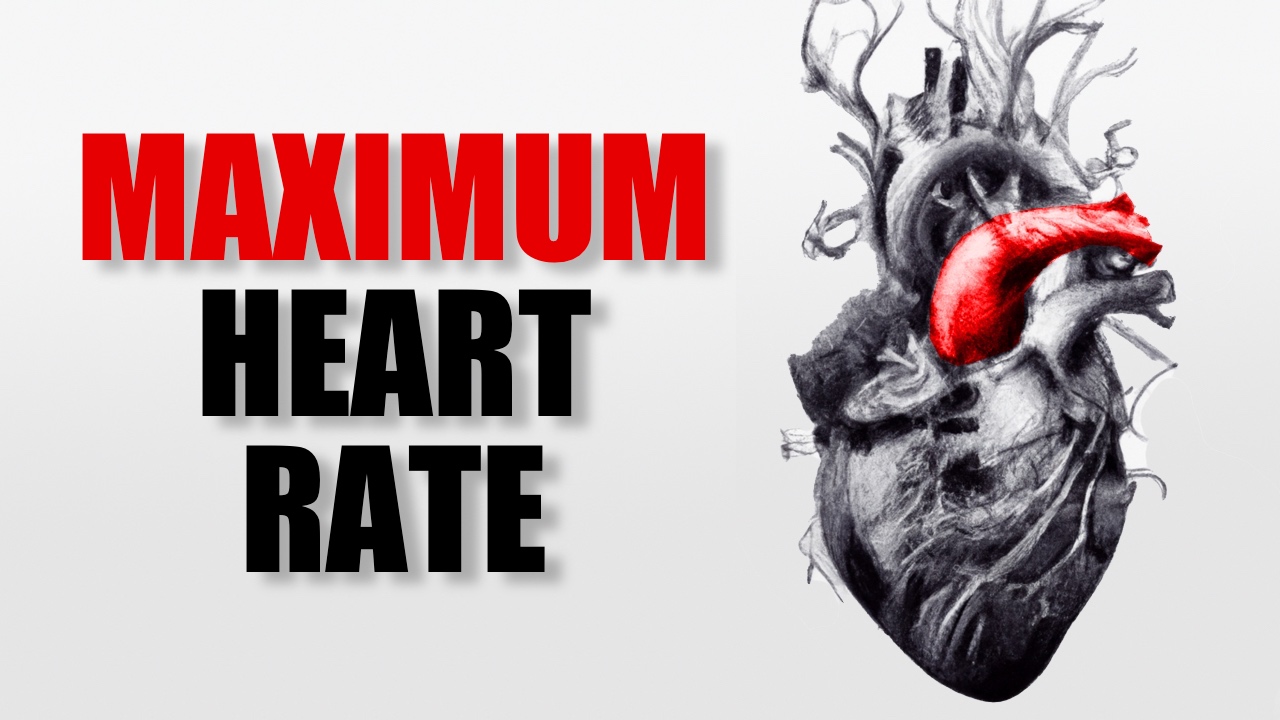
Hi Sean,
Thanks for this interesting and very BIG article ! You dig deep !
I am looking at the literature related to the different formulas and try to find a way to have a formula for different profiles (ex beginner, moderately trained, highly trained…).
I am reading through this paper : https://www.ncbi.nlm.nih.gov/pmc/articles/PMC7523886/
All the formulas seem very similar in terms of precision or margin of errors. But I can not find a formula specific for endurance athlete for example. Do you have some ressources to give me ?
Thanks Sean !
Hi Alexandre, As explained in the article, there are no valid formulas to calculate max heart rate. Training zones based on percentages of max heart rate are even less reliable. I would recommend using RPE (rating of perceived exertion) instead. Stay tuned as in January I will be launching a practical tool about this!